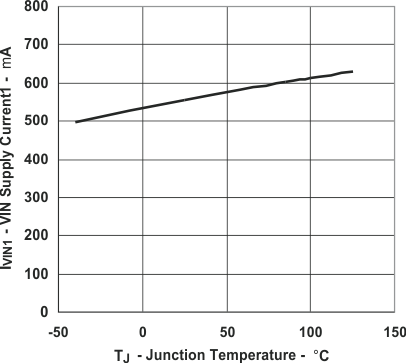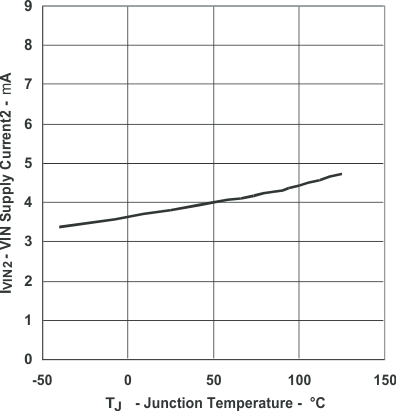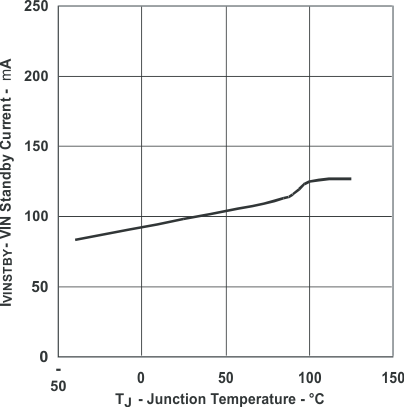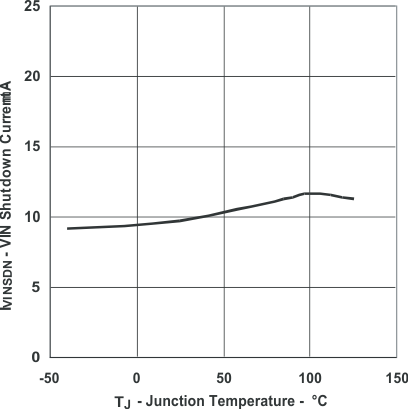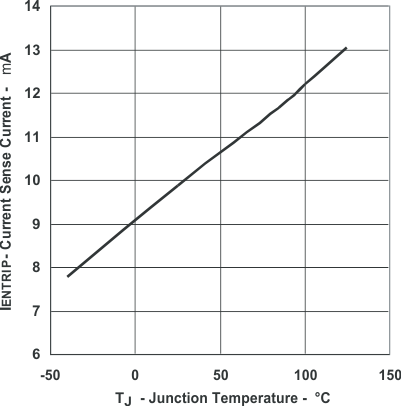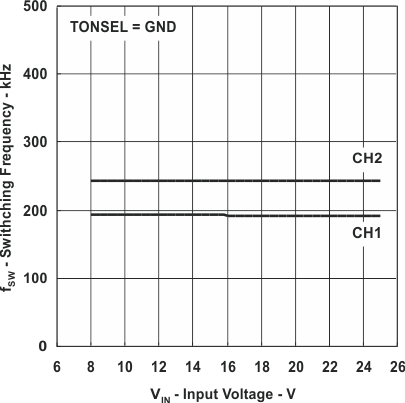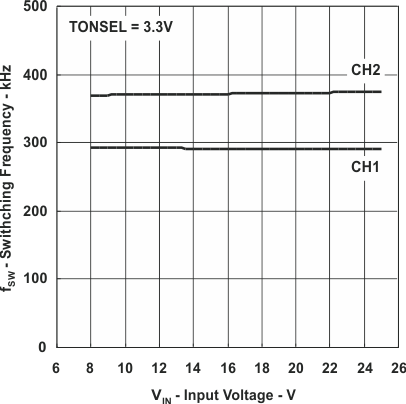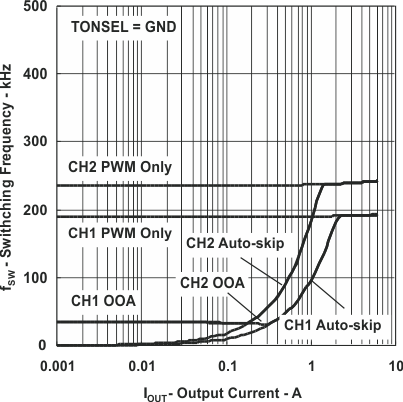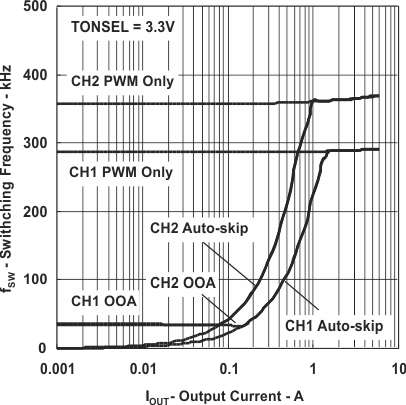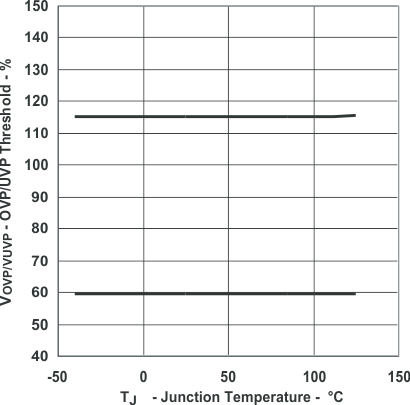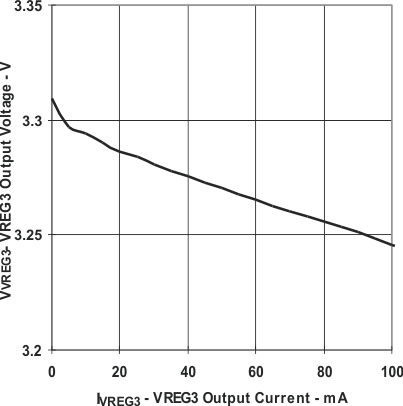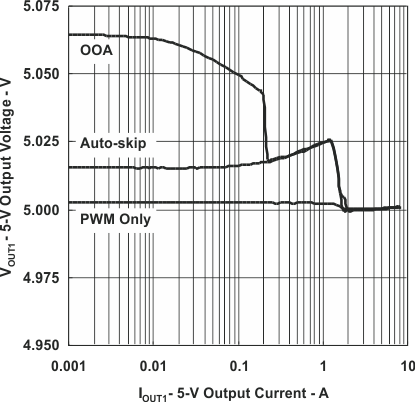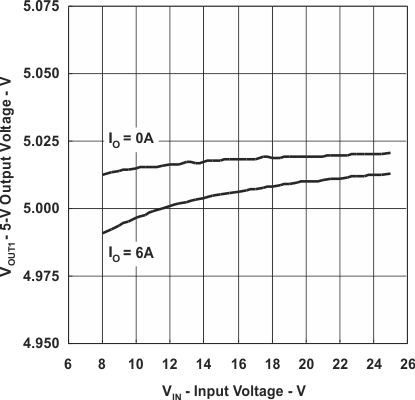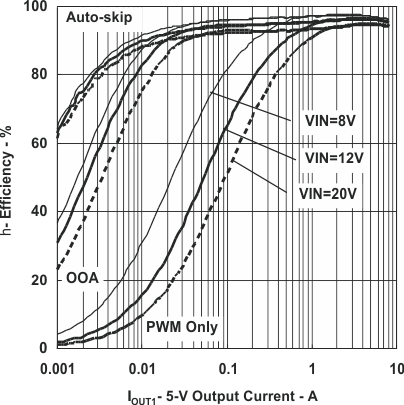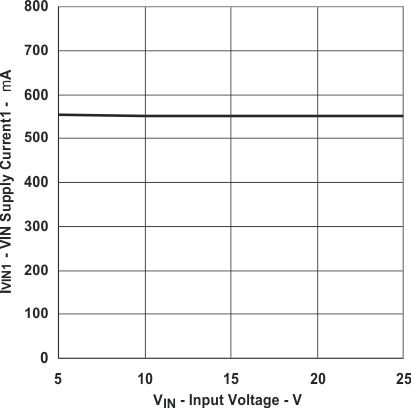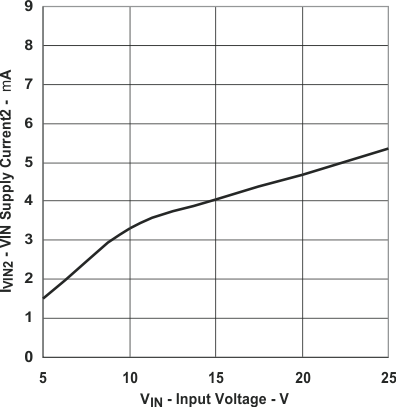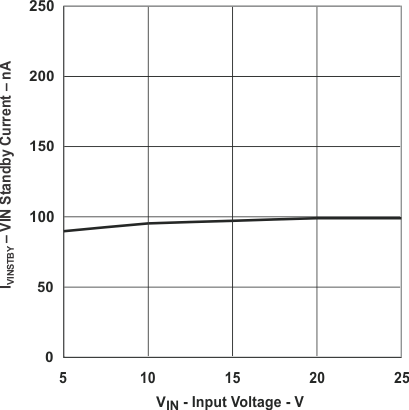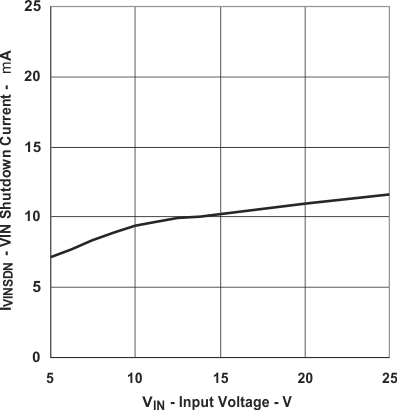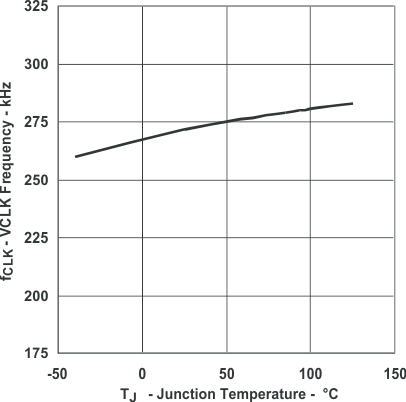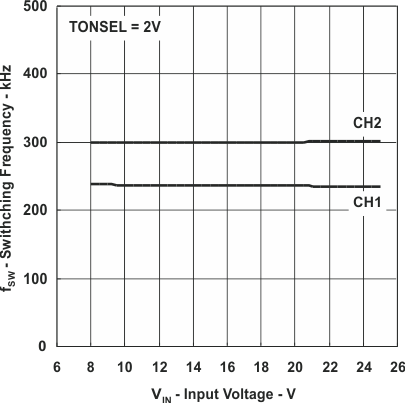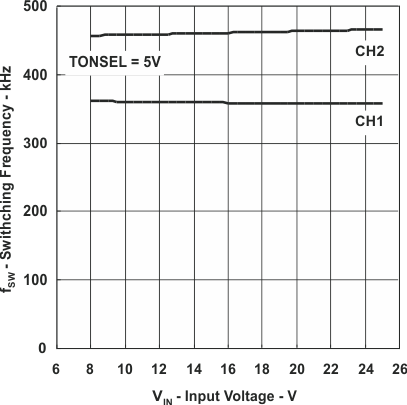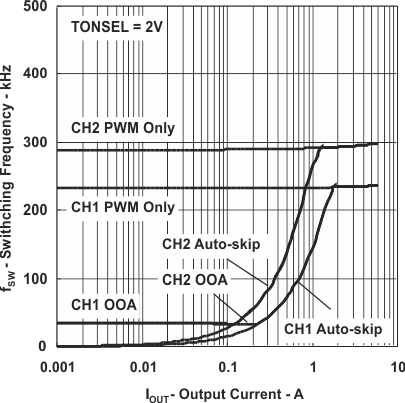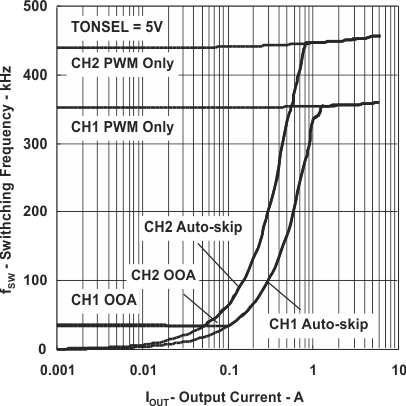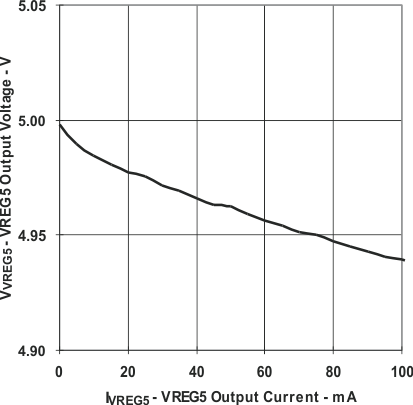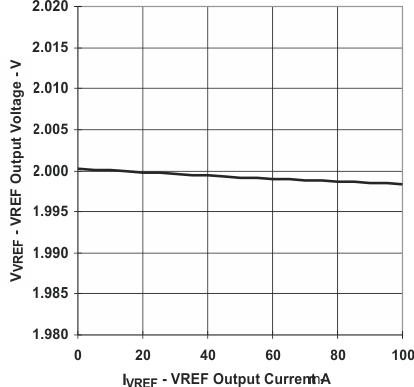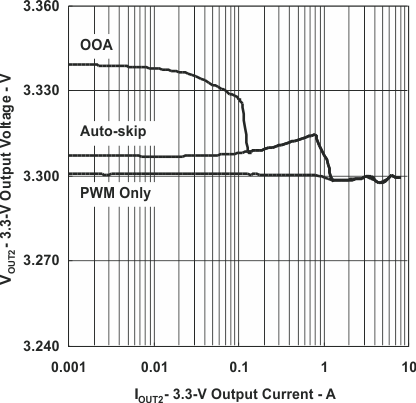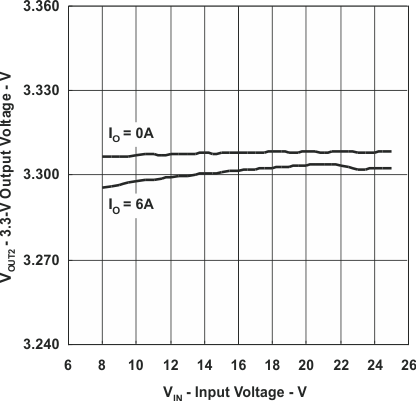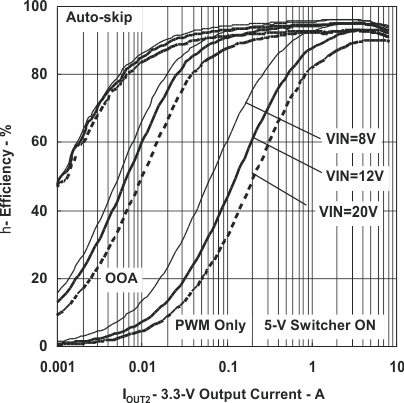SLUS786H OCTOBER 2007 – January 2015 TPS51125
PRODUCTION DATA.
- 1 Features
- 2 Applications
- 3 Description
- 4 Revision History
- 5 Pin Configuration and Functions
- 6 Specifications
-
7 Detailed Description
- 7.1 Overview
- 7.2 Functional Block Diagram
- 7.3
Feature Description
- 7.3.1 PWM Operations
- 7.3.2 Adaptive On-Time Control and PWM Frequency
- 7.3.3 Loop Compensation
- 7.3.4 Ramp Signal
- 7.3.5 Light-Load Condition in Auto-Skip Operation
- 7.3.6 Out-of-Audio Light-Load Operation
- 7.3.7 VREG5/VREG3 Linear Regulators
- 7.3.8 VREG5 Switch Over
- 7.3.9 VREG3 Switch Over
- 7.3.10 Powergood
- 7.3.11 Output Discharge Control
- 7.3.12 Low-Side Driver
- 7.3.13 High-Side Driver
- 7.3.14 VCLK for Charge Pump
- 7.3.15 Current Protection
- 7.3.16 Overvoltage and Undervoltage Protection
- 7.3.17 UVLO Protection
- 7.3.18 Thermal Shutdown
- 7.4 Device Functional Modes
- 8 Application and Implementation
- 9 Power Supply Recommendations
- 10Layout
- 11Device and Documentation Support
- 12Mechanical, Packaging, and Orderable Information
Package Options
Mechanical Data (Package|Pins)
- RGE|24
Thermal pad, mechanical data (Package|Pins)
- RGE|24
Orderable Information
6 Specifications
6.1 Absolute Maximum Ratings(1)
over operating free-air temperature range (unless otherwise noted)| MIN | MAX | UNIT | |||
|---|---|---|---|---|---|
| Input voltage(1) | VBST1, VBST2 | –0.3 | 36 | V | |
| VIN | –0.3 | 30 | |||
| LL1, LL2 | –2.0 | 30 | |||
| LL1, LL2, pulse width < 20 ns | –5.0 | 30 | |||
| VBST1, VBST2 (2) | –0.3 | 6 | |||
| EN0, ENTRIP1, ENTRIP2, VFB1, VFB2, VO1, VO2, TONSEL, SKIPSEL | –0.3 | 6 | |||
| Output voltage(1) | DRVH1, DRVH2 | –1.0 | 36 | ||
| DRVH1, DRVH2(2) | –0.3 | 6 | |||
| PGOOD, VCLK, VREG3, VREG5, VREF, DRVL1, DRVL2 | –0.3 | 6 | |||
| Junction temperature, TJ | –40 | 125 | °C | ||
| Storage temperature, Tstg | –55 | 150 | °C | ||
(1) Stresses beyond those listed under Absolute Maximum Ratings may cause permanent damage to the device. These are stress ratings only and functional operation of the device at these or any other conditions beyond those indicated under Recommended Operating Conditions is not implied. Exposure to absolute-maximum-rated conditions for extended periods may affect device reliability.
(2) Voltage values are with respect to the corresponding LLx terminal.
6.2 ESD Ratings
| VALUE | UNIT | |||
|---|---|---|---|---|
| V(ESD) | Electrostatic discharge | Human body model (HBM), per ANSI/ESDA/JEDEC JS-001(1) | ±2000 | V |
| Charged-device model (CDM), per JEDEC specification JESD22-C101(2) | ±1500 | |||
(1) JEDEC document JEP155 states that 500-V HBM allows safe manufacturing with a standard ESD control process.
(2) JEDEC document JEP157 states that 250-V CDM allows safe manufacturing with a standard ESD control process.
6.3 Recommended Operating Conditions
over operating free-air temperature range (unless otherwise noted)| MIN | MAX | UNIT | ||
|---|---|---|---|---|
| Supply voltage | VIN | 5.5 | 28 | V |
| Input voltage | VBST1, VBST2 | –0.1 | 34 | |
| VBST1, VBST2 (with respect to LLx) | –0.1 | 5.5 | ||
| EN0, ENTRIP1, ENTRIP2, VFB1, VFB2, VO1, VO2, TONSEL, SKIPSEL | –0.1 | 5.5 | ||
| Output voltage | DRVH1, DRVH2 | –0.8 | 34 | |
| DRVH1, DRVH2 (with respect to LLx) | –0.1 | 5.5 | ||
| LL1, LL2 | –1.8 | 28 | ||
| VREF, VREG3, VREG5 | –0.1 | 5.5 | ||
| PGOOD, VCLK, DRVL1, DRVL2 | –0.1 | 5.5 | ||
| Operating free-air temperature | –40 | 85 | °C | |
6.4 Thermal Information
| THERMAL METRIC(1) | TPS51125 | UNIT | |
|---|---|---|---|
| VQFN | |||
| 24 PINS | |||
| RθJA | Junction-to-ambient thermal resistance | 34.2 | °C/W |
| RθJC(top) | Junction-to-case (top) thermal resistance | 37.2 | |
| RθJB | Junction-to-board thermal resistance | 12.4 | |
| ψJT | Junction-to-top characterization parameter | 0.4 | |
| ψJB | Junction-to-board characterization parameter | 12.4 | |
| RθJC(bot) | Junction-to-case (bottom) thermal resistance | 2.8 | |
(1) For more information about traditional and new thermal metrics, see the IC Package Thermal Metrics application report, SPRA953.
6.5 Electrical Characteristics
over operating free-air temperature range, VIN = 12 V (unless otherwise noted)| PARAMETER | TEST CONDITIONS | MIN | TYP | MAX | UNIT | |
|---|---|---|---|---|---|---|
| SUPPLY CURRENT | ||||||
| IVIN1 | VIN supply current1 | VIN current, TA = 25°C, no load, VO1 = 0 V, VO2 = 0 V, EN0=open, ENTRIPx = 5 V, VFB1 = VFB2 = 2.05 V |
0.55 | 1 | mA | |
| IVIN2 | VIN supply current2 | VIN current, TA = 25°C, no load, VO1 = 5 V, VO2 = 3.3 V, EN0=open, ENTRIPx = 5 V, VFB1 = VFB2 = 2.05 V |
4 | 6.5 | μA | |
| IVO1 | VO1 current | VO1 current, TA = 25°C, no load, VO1 = 5 V, VO2 = 3.3 V, EN0=open, ENTRIPx = 5 V, VFB1 = VFB2 = 2.05 V |
0.8 | 1.5 | mA | |
| IVO2 | VO2 current | VO2 current, TA = 25°C, no load, VO1 = 5 V, VO2 = 3.3 V, EN0=open, ENTRIPx = 5 V, VFB1 = VFB2 = 2.05 V |
12 | 100 | μA | |
| IVINSTBY | VIN standby current | VIN current, TA = 25°C, no load, EN0 = 1.2 V, ENTRIPx = 0 V |
95 | 250 | ||
| IVINSDN | VIN shutdown current | VIN current, TA = 25°C, no load, EN0 = ENTRIPx = 0 V |
10 | 25 | ||
| VREF OUTPUT | ||||||
| VVREF | VREF output voltage | IVREF = 0 A | 1.98 | 2.00 | 2.02 | V |
| -5 μA < IVREF < 100 μA | 1.97 | 2.00 | 2.03 | |||
| VREG5 OUTPUT | ||||||
| VVREG5 | VREG5 output voltage | VO1 = 0 V, IVREG5 < 100 mA, TA = 25°C | 4.8 | 5 | 5.2 | V |
| VO1 = 0 V, IVREG5 < 100 mA, 6.5 V < VIN < 28 V | 4.75 | 5 | 5.25 | |||
| VO1 = 0 V, IVREG5 < 50 mA, 5.5 V < VIN < 28 V | 4. 75 | 5 | 5.25 | |||
| IVREG5 | VREG5 output current | VO1 = 0 V, VREG5 = 4.5 V | 100 | 175 | 250 | mA |
| VTH5VSW | Switch over threshold | Turns on | 4.55 | 4.7 | 4.85 | V |
| Hysteresis | 0.15 | 0.25 | 0.3 | |||
| R5VSW | 5 V SW RON | VO1 = 5 V, IVREG5 = 100 mA | 1 | 3 | Ω | |
| VREG3 OUTPUT | ||||||
| VVREG3 | VREG3 output voltage | VO2 = 0 V, IVREG3 < 100 mA, TA= 25°C | 3.2 | 3.33 | 3.46 | V |
| VO2 = 0 V, IVREG3 < 100 mA, 6.5 V < VIN < 28 V | 3.13 | 3.33 | 3.5 | |||
| VO2 = 0 V, IVREG3 < 50 mA, 5.5 V < VIN < 28 V | 3.13 | 3.33 | 3.5 | |||
| IVREG3 | VREG3 output current | VO2 = 0 V, VREG3 = 3 V | 100 | 175 | 250 | mA |
| VTH3VSW | Switch over threshold | Turns on | 3.05 | 3.15 | 3.25 | V |
| Hysteresis | 0.1 | 0.2 | 0.25 | |||
| R3VSW | 3 V SW RON | VO2 = 3.3 V, IVREG3 = 100 mA | 1.5 | 4 | Ω | |
| INTERNAL REFERENCE VOLTAGE | ||||||
| VIREF | Internal reference voltage | IVREF = 0 A, beginning of ON state | 1.95 | 1.98 | 2.01 | V |
| VVFB | VFB regulation voltage | FB voltage, IVREF = 0 A, skip mode | 1.98 | 2.01 | 2.04 | |
| FB voltage, IVREF = 0 A, OOA mode (1) | 2.00 | 2.035 | 2.07 | |||
| FB voltage, IVREF = 0 A, continuous conduction (1) | 2.00 | |||||
| IVFB | VFB input current | VFBx = 2.0 V, TA= 25°C | –20 | 20 | nA | |
| VOUT DISCHARGE | ||||||
| IDischg | VOUT discharge current | ENTRIPx = 0 V, VOx = 0.5 V | 10 | 60 | mA | |
| OUTPUT DRIVERS | ||||||
| RDRVH | DRVH resistance | Source, VBSTx - DRVHx = 100 mV | 4 | 8 | Ω | |
| Sink, VDRVHx - LLx = 100 mV | 1.5 | 4 | ||||
| RDRVL | DRVL resistance | Source, VVREG5 - DRVLx = 100 mV | 4 | 8 | ||
| Sink, VDRVLx = 100 mV | 1.5 | 4 | ||||
| tD | Dead time | DRVHx-off to DRVLx-on | 10 | ns | ||
| DRVLx-off to DRVHx-on | 30 | |||||
| CLOCK OUTPUT | ||||||
| VCLKH | High level voltage | IVCLK = -10 mA, VO1 = 5 V, TA = 25 °C | 4.84 | 4.92 | V | |
| VCLKL | Low level voltage | IVCLK = 10 mA, VO1 = 5 V, TA = 25 °C | 0.06 | 0.12 | ||
| fCLK | Clock frequency | TA = 25 °C | 175 | 270 | 325 | kHz |
| INTERNAL BST DIODE | ||||||
| VFBST | Forward voltage | VVREG5-VBSTx, IF = 10 mA, TA = 25 °C | 0.7 | 0.8 | 0.9 | V |
| IVBSTLK | VBST leakage current | VBSTx = 34 V, LLx = 28 V, TA = 25 °C | 0.1 | 1 | μA | |
| DUTY AND FREQUENCY CONTROL | ||||||
| tON11 | CH1 on time 1 | VIN = 12 V, VO1 = 5 V, 200 kHz setting | 2080 | ns | ||
| tON12 | CH1 on time 2 | VIN = 12 V, VO1 = 5 V, 245 kHz setting | 1700 | |||
| tON13 | CH1 on time 3 | VIN = 12 V, VO1 = 5 V, 300 kHz setting | 1390 | |||
| tON14 | CH1 on time 4 | VIN = 12 V, VO1 = 5 V, 365 kHz setting | 1140 | |||
| tON21 | CH2 on time 1 | VIN = 12 V, VO2 = 3.3 V, 250 kHz setting | 1100 | |||
| tON22 | CH2 on time 2 | VIN = 12 V, VO2 = 3.3 V, 305 kHz setting | 900 | |||
| tON23 | CH2 on time 3 | VIN = 12 V, VO2 = 3.3 V, 375 kHz setting | 730 | |||
| tON24 | CH2 on time 4 | VIN = 12 V, VO2 = 3.3 V, 460 kHz setting | 600 | |||
| tON(min) | Minimum on time | TA = 25 °C | 80 | |||
| tOFF(min) | Minimum off time | TA = 25 °C | 300 | |||
| SOFT-START | ||||||
| tSS | Internal SS time | Internal soft start | 1.1 | 1.6 | 2.1 | ms |
| POWERGOOD | ||||||
| VTHPG | PG threshold | PG in from lower | 92.50% | 95% | 97.50% | |
| PG in from higher | 102.50% | 105% | 107.50% | |||
| PG hysteresis | 2.50% | 5% | 7.50% | |||
| IPGMAX | PG sink current | PGOOD = 0.5 V | 5 | 12 | mA | |
| tPGDEL | PG delay | Delay for PG in | 350 | 510 | 670 | μs |
| LOGIC THRESHOLD AND SETTING CONDITIONS | ||||||
| VEN0 | EN0 setting voltage | Shutdown | 0.4 | V | ||
| Enable, VCLK = off | 0.8 | 1.6 | ||||
| Enable, VCLK = on | 2.4 | |||||
| IEN0 | EN0 current | VEN0 = 0.2 V | 2 | 3.5 | 5 | μA |
| VEN0 = 1.5 V | 1 | 1.75 | 2.5 | |||
| VEN | ENTRIP1, ENTRIP2 threshold | Shutdown | 350 | 400 | 450 | mV |
| Hysteresis | 10 | 30 | 60 | |||
| VTONSEL | TONSEL setting voltage | 200 kHz/250 kHz | 1.5 | V | ||
| 245 kHz/305 kHz | 1.9 | 2.1 | ||||
| 300 kHz/375 kHz | 2.7 | 3.6 | ||||
| 365 kHz/460 kHz | 4.7 | |||||
| VSKIPSEL | SKIPSEL setting voltage | PWM only | 1.5 | |||
| Auto skip | 1.9 | 2.1 | ||||
| OOA auto skip | 2.7 | |||||
| PROTECTION: CURRENT SENSE | ||||||
| IENTRIP | ENTRIPx source current | VENTRIPx = 920 mV, TA= 25°C | 9.4 | 10 | 10.6 | μA |
| TCIENTRIP | ENTRIPx current temperature coefficient | On the basis of 25°C(1) | 4500 | ppm/°C | ||
| VOCLoff | OCP comparator offset | ((VENTRIPx-GND/9)-24 mV -VGND-LLx) voltage, VENTRIPx-GND = 920 mV | –8 | 0 | 8 | mV |
| VOCL(max) | Maximum OCL setting | VENTRIPx = 5 V | 185 | 205 | 225 | |
| VZC | Zero cross detection comparator offset | VGND-LLx voltage | –5 | 0 | 5 | |
| VENTRIP | Current limit threshold | VENTRIPx-GND voltage, (1) | 0.515 | 2 | V | |
| PROTECTION: UNDERVOLTAGE AND OVERVOLTAGE | ||||||
| VOVP | OVP trip threshold | OVP detect | 110% | 115% | 120% | |
| tOVPDEL | OVP prop delay | 2 | μs | |||
| VUVP | Output UVP trip threshold | UVP detect | 55% | 60% | 65% | |
| Hysteresis | 10% | |||||
| tUVPDEL | Output UVP prop delay | 20 | 32 | 40 | μs | |
| tUVPEN | Output UVP enable delay | 1.4 | 2 | 2.6 | ms | |
| UVLO | ||||||
| VUVVREG5 | VREG5 UVLO threshold | Wake up | 4.1 | 4.2 | 4.3 | V |
| Hysteresis | 0.38 | 0.43 | 0.48 | |||
| VUVVREG3 | VREG3 UVLO threshold | Shutdown (1) | VO2-1 | |||
| THERMAL SHUTDOWN | ||||||
| TSDN | Thermal shutdown threshold | Shutdown temperature (1) | 150 | °C | ||
| Hysteresis (1) | 10 | |||||
(1) Ensured by design. Not production tested.
6.6 Typical Characteristics
